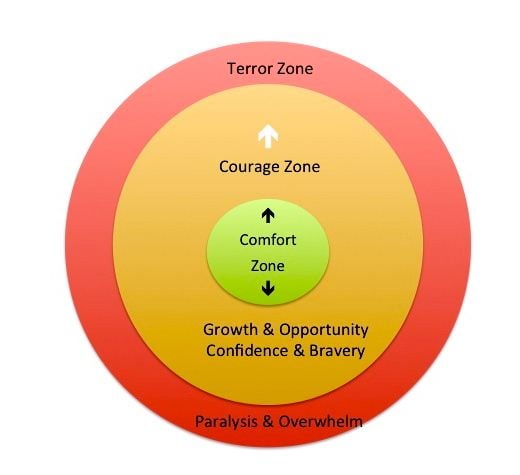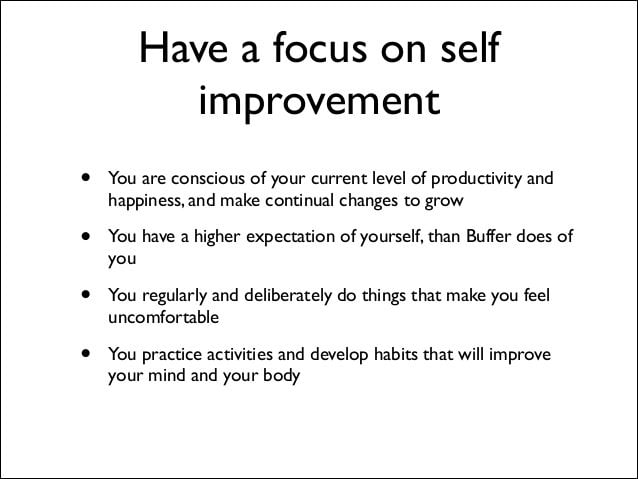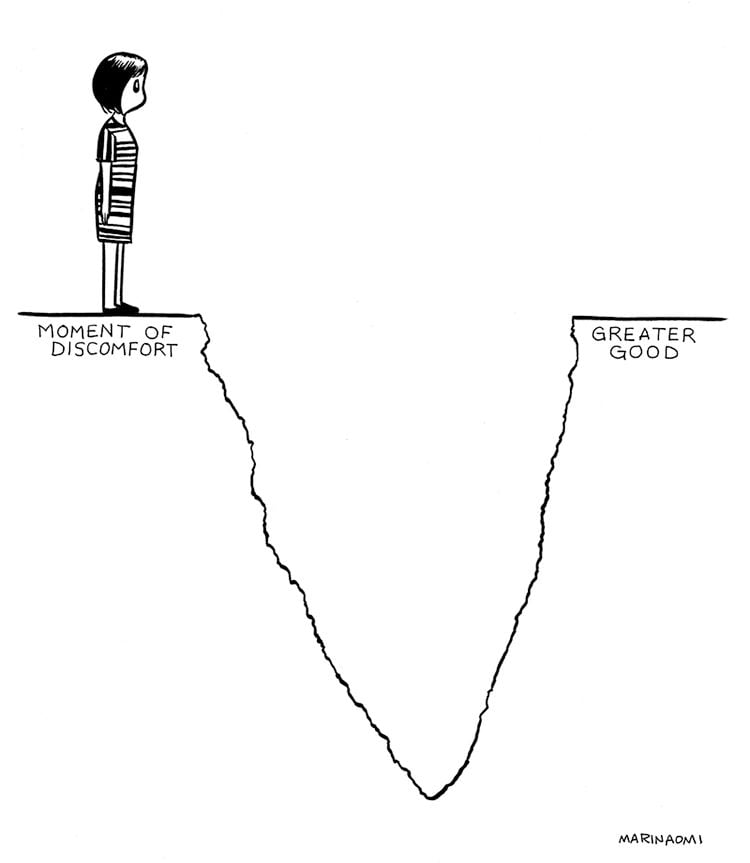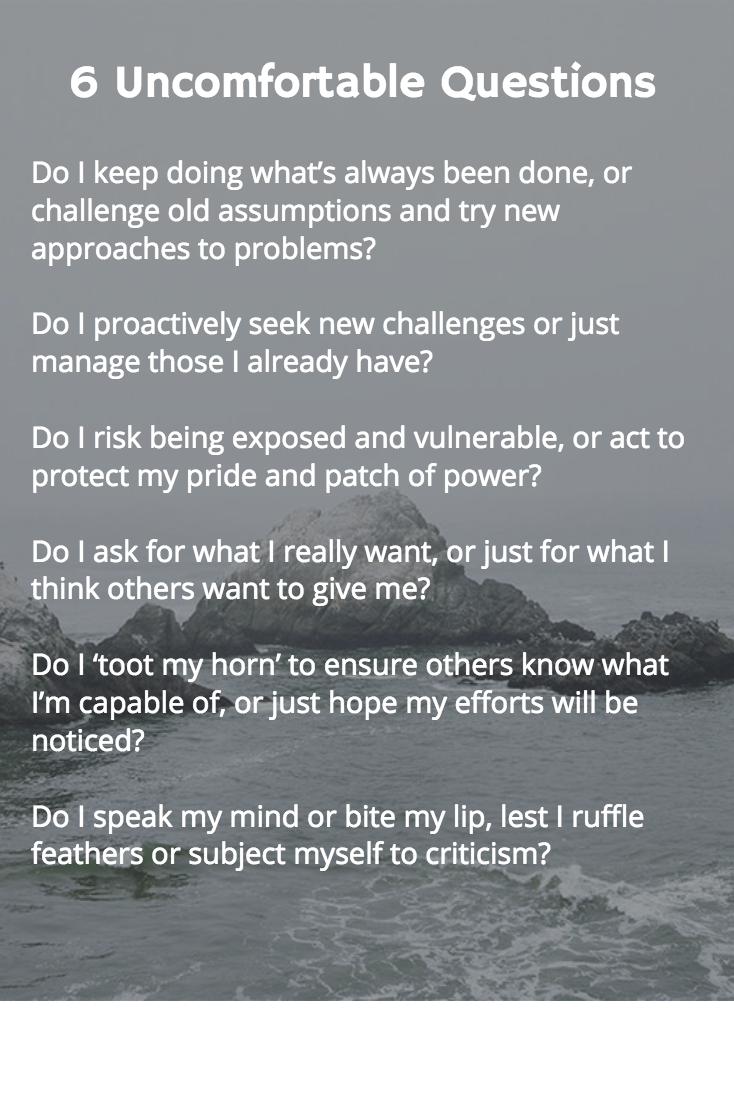I am quite possibly the world’s biggest fan of being comfortable.
The word, to me, conjures up an image of a big comfy couch, a roaring fireplace, and maybe a sleepy puppy to curl up with. What could be better?
So it has been a challenging, repeated lesson for me to learn that feeling uncomfortable is pretty much the only way to experience real personal growth.
I didn’t want to believe this for much of my life, and I often still rail against it now. But more and more often, I’m learning to lean into what I’ve come to call “the healthy uncomfortable.”
By this, I mean getting out of my comfort zone and doing things that seem a little impossible (or at least a tiny bit scary)—getting into the “courage zone” of the graphic here:

Buffer’s values of self-improvement, reflection, and bias toward action have helped me immensely here. In fact, feeling uncomfortable is baked right into our values:

It’s not the easiest habit to cultivate, but it just might be the one with the biggest payoff. Luckily, there are plenty of opportunities to practice the healthy uncomfortable. Here are 5 of them. Let’s get uncomfortable!
Uncomfortably sharing new ideas and skills
Reid Hoffman, the founder of LinkedIn, said something once that will probably live in startup infamy forevermore:
If you are not embarrassed by the first version of your product, you’ve launched too late.
This “start before you’re ready” attitude isn’t just for startups: It’s good advice for anyone trying something new.
I’m learning that feeling the healthy uncomfortable is a sign that you’re trying something (pretty much the most important step to succeeding).
When you do things like share the first portrait you’ve painted, speak a new language you’re learning to a local for the first time, or get up on stage to share a talk or personal experience, every cell of your body is going to push back against the idea.
That’s the sign you’re on the right track. If you’re not embarrassed, you’re probably too late.
Uncomfortably giving feedback
A different kind of uncomfortable lives in the idea of giving and receiving feedback.
In what I consider to be the ultimate guide to the healthy uncomfortable, the book Daring Greatly, author Brené Brown has some great advice on feedback:
“I believe that feedback thrives in cultures where the goal is not ‘getting comfortable with hard conversations’ but normalizing discomfort. If leaders expect real learning, critical thinking, and change, then discomfort should be normalized: ‘We believe growth and learning are uncomfortable so it’s going to happen here— you’re going to feel that way. We want you to know that it’s normal and it’s an expectation here. You’re not alone and we ask that you stay open and lean into it.’ This is true at all levels and in all organizations, schools, faith communities, and even families.”
So not only do we have to get comfortable with being uncomfortable, we have to stay that way.
For a long time, this idea seemed almost unbearable to me. And then I saw this image by an incredible illustrator, MariNaomi:

Talk about daring greatly! Crossing the scary chasm of the moment of discomfort looks like an impossible leap, but for the sake of what’s on the other side, don’t we have to try?
Rearranging my mind to view feedback as a kindness that we offer to a person—or to the world!—when a person or situation truly matters to us has been one of the hardest and most rewarding things I’ve ever done.
Uncomfortably leading
I’m very lucky to be surrounded by leaders at Buffer who are experts at leaning in to the uncomfortable.
In fact, their influence is absolutely the reason I’ve been able to dare even a little bit greatly. The world is changed by those who are willing to become comfortable with discomfort.
In Tribes: We Need You to Lead Us, Seth Godin writes:
“Leadership is scarce because few people are willing to go through the discomfort required to lead. This scarcity makes leadership valuable.… It’s uncomfortable to stand up in front of strangers. It’s uncomfortable to propose an idea that might fail. It’s uncomfortable to challenge the status quo. It’s uncomfortable to resist the urge to settle. When you identify the discomfort, you’ve found the place where a leader is needed. If you’re not uncomfortable in your work as a leader, it’s almost certain you’re not reaching your potential as a leader.”
Uncomfortably building things
One way leaders can coax you into your true potential with the healthy uncomfortable is by, well, not giving you much other choice.
Maybe it’s a bit like giving the hesitating skydiver just the tiniest nudge out of the plane—guiding someone toward the decision they ultimately want to make at the moment they might be most tempted to default to fear.
Leo and Joel shared a great resource with the team not too long along around the concept of focusing on speed as a habit.
In the article, Dave Girouard, known for building Google’s enterprise apps division into a global business, shares that a certain level of discomfort means you’re moving at the right speed: “Gauging comfort on your team is a really helpful measure of whether you’re going fast enough or not. You know you’re going fast enough if there’s a low-level discomfort, people feeling stretched. But if you’re going too fast, you’ll see it on their faces, and that’s important to spot too.”
Girouard offers some insights about what this feeling looked like in practice at Google:
“While I was at Google, Larry Page was extremely good at forcing decisions so fast that people were worried the team was about to drive the car off a cliff. He’d push it as far as he could go without people crossing that line of discomfort. It was just his fundamental nature to ask, ‘Why not? Why can’t we do it faster than this?’ and then wait to see if people started screaming. He really rallied everyone around this theory that fast decisions, unless they’re fatal, are always better.”
Uncomfortably creating
As a writer, I’ve discovered that uncomfortable creativity is a principle I need to rediscover and re-commit to over and over again.
The more you create, the more comfortable it becomes to you—until you again get up the nerve to push yourself to that next plateau.
This is the kind of healthy uncomfortable that we’ve been recommitting to recently at Buffer. Leo defined it as the “internal struggle” over whether to hit publish.
“This is about self-discipline to go through that struggle, even if it’s felt ever so slightly, every single time. We don’t want to become churners – that churn out posts, or tweets… Every single piece of content is the only one that matters. We give it all of our attention, we want to make it excellent and we have a slight feeling of vulnerability and discomfort when we get it out… That is what creates the volatility of the piece, the opportunity for it to rise above everything else we’ve written so far.”
Chasing this feeling is incredibly counterintuitive—it’s nerve-wracking to share something personal, or weird, or different, and have no idea what kind of response you’re going to get.
I’ve learned it requires real practice and reflection to stretch to that edge. The feeling doesn’t get easier—but more often than not, it might just be worth it.
Let’s get uncomfortable! 6 questions for greater vulnerability
Can you create a habit of cultivating the healthy uncomfortable? I think you can.
Margie Warrell, author of Stop Playing Safe, offers up a few great question in a Forbes article that I’m going to use whenever I need to “re-up” on my commitment to the healthy uncomfortable.
- Do I keep doing what’s always been done, or challenge old assumptions and try new approaches to problems?
- Do I proactively seek new challenges or just manage those I already have?
- Do I risk being exposed and vulnerable, or act to protect my pride and patch of power?
- Do I ask for what I really want, or just for what I think others want to give me?
- Do I ‘toot my horn’ to ensure others know what I’m capable of, or just hope my efforts will be noticed?
- Do I speak my mind or bite my lip, lest I ruffle feathers or subject myself to criticism?

How do you make yourself uncomfortable?
Does this idea of the healthy uncomfortable resonate with you? When is the last time you felt it? How do you stretch yourself in new and exciting directions? I’d love to hear all your thoughts in the comments!
Try Buffer for free
190,000+ creators, small businesses, and marketers use Buffer to grow their audiences every month.



